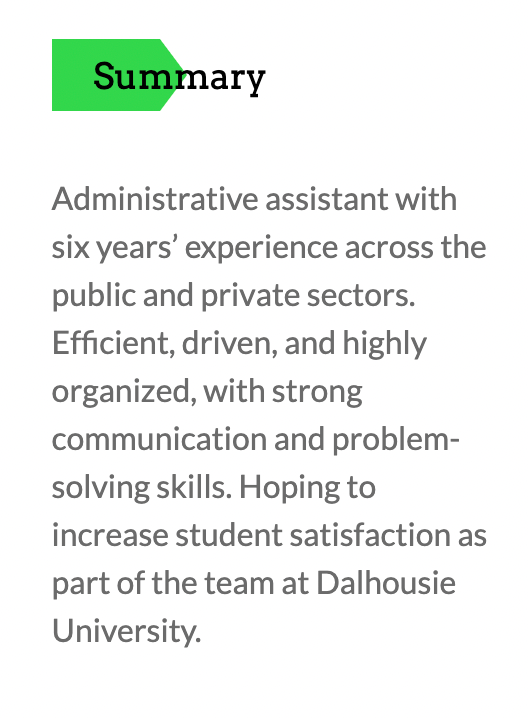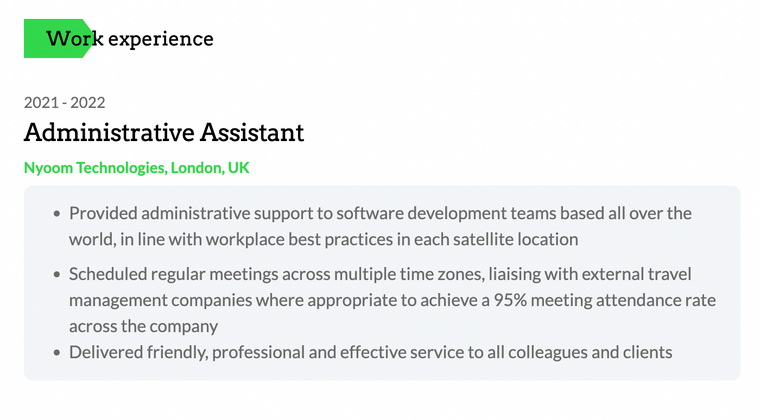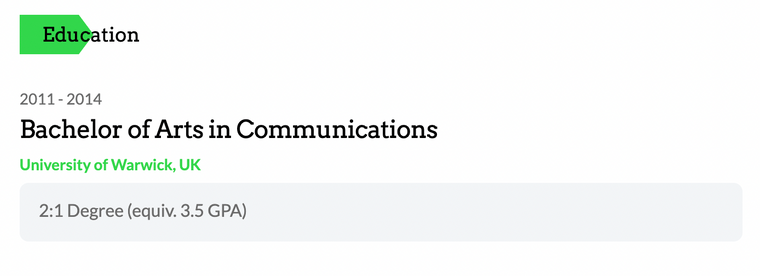Resume in Canadian Format: Canadian resume samples and examples
Hoping to live and work in Canada? Our guide to resumes in Canadian format will get you off to a great start!

Are you hoping to live and work in Canada? We can’t blame you if so – it’s a beautiful country with a reputation for welcoming people from all around the world. Between the friendly, open culture and the beautiful northern scenery, what’s not to love about the prospect of a brand new life abroad?
But if you want to live the life of your dreams in Canada, you’ll need to be able to find a job to support yourself. That means learning how to write a resume in the Canadian format, which has some important differences from other resume formats around the world. Wherever you come from, you’ll probably need to make at least a few changes to your resume if you want to find employment in Canada.
To get you started, we’ve put together this guide to writing your first Canadian resume! We’ll cover all of the following points:
- Why you need a Canadian resume
- The key differences between Canadian resumes and resumes from elsewhere
- What to call attention to when writing your Canadian resume
- How to lay out your Canadian resume
Why Write a Resume in the Canadian Format?
Simply put, you need to write a resume in the Canadian format to maximize your chances of finding a job in Canada.
If you’re coming to Canada from the US, you’ll probably have an easier time, as the two countries share a lot of the same values when it comes to resumes. Though you’ll need to make a few important tweaks, you probably won’t need to overhaul your entire resume to keep Canadian employers happy.
But many people move to Canada from much farther afield, and end up surprised by the differences in employment norms. If you’re coming to Canada from a country where things are done differently, the process of reworking your resume can cost you valuable time on your job search. It could delay your ability to find a job, and to start earning a living in your new country.
If you show up prepared, you’ll have a much easier time. There’s already enough work involved in moving to a new country! Get this task out of the way early, and save yourself some stress once you arrive in Canada.
Key Features of a Canadian Resume
To help you get started on your Canadian resume, here are some of the key features of a resume in the Canadian style. If you’re wondering what differences you need to watch out for, look no further – we’ve got your back!
No Photos
In the US, the subject of whether or not to include a photo of yourself on your resume is hotly debated. Some people believe it’s inherently unprofessional, unless you’re applying for a job that relies on your appearance – like modeling or acting. Other people believe it’s a great way to give your resume more of a personal touch.
But in Canada, that debate simply doesn’t exist. If you want to find a job in Canada, you shouldn’t include a photo of yourself on your resume.
That’s because your physical appearance isn’t considered relevant to your employability. It’s also worth considering that including a photo of yourself may increase your risk of facing discrimination in the hiring process, particularly if you’re a person of color, gender non-conforming, or a member of another visible minority group. When applying for jobs in Canada, it’s expected that you will leave the photo out.
No Personal Details
The same principle applies to other personal details that you might be tempted to include on your resume. When job searching in Canada, you should avoid including any of the following information:
- Your race, background or ethnicity
- Your age
- Any physical attributes
- Your marital status
- Whether you have children
- Your sexual orientation
None of this is information that will help an employer decide whether or not to hire you. In fact, due to discrimination laws, it may be against the law for them to take this information into account when considering you as a candidate!
Two Page Maximum
In this respect, Canadian resume standards are fairly similar to American resume standards. You should avoid allowing your resume to take up more than two pages. If you’re a recent graduate or a junior employee, you should aim to limit it to a single page if possible.
Remember, a longer resume doesn’t innately prove that you have more experience. In most cases, all it will prove is that you lack the ability to express yourself concisely. Being able to summarize your skills and experience is a talent in its own right, and hiring managers will be on the lookout for it.
Reverse-Chronological Format
A reverse-chronological resume format is the default resume format in North America. But if you’re not familiar with the term, don’t panic! It just means a resume that lists your work experience from the most recent item to the oldest item.
Under exceptional circumstances, you may want to use a functional resume format instead. If you’re a recent graduate or you have extensive gaps in your work history, this skills-focused resume format will allow you to minimize both your lack of experience and any interruptions to your employment. This format is also accepted in Canada, though it’s much less common than the reverse-chronological format.
What to Highlight on Your Canadian Resume
Once you’ve figured out the most important features of your Canadian resume, it’s time to think about what you can highlight as you write. There are certain qualities and experiences that will give you an edge when looking for your first job in Canada, so make sure you include as many of them as you can!
Canadian Work Experience
Canadian employers strongly value existing Canadian work experience. It’s evidence that you can mesh well with the social and professional norms of a Canadian workplace. Unfortunately, this can make it difficult for newcomers to Canada to find a way into the Canadian workforce – if you don’t already have Canadian work experience, it can be surprisingly hard to obtain any.
That’s why, if you do have Canadian work experience, it should be front and center on your Canadian resume. It will give you a huge advantage as you look for work in Canada!
For the purposes of this guide, ‘Canadian work experience’ is a fairly broad umbrella term. Ideally, Canadian employers will want to see experience of working for a Canadian company. However, if you’ve worked in collaboration with a Canadian company or team while employed elsewhere, that will also give you an advantage on the Canadian job market.
Experience Working Internationally
If you don’t have Canadian work experience – and if you’re new to Canada, you probably don’t – then experience working with international collaborators in general is a useful substitute.
Being able to work with people from other countries shows that you are adaptable, flexible, and willing to learn about other people’s workplace norms and standards. When you’re looking for work internationally, it’s extremely useful to be able to point to experience of international collaboration – even if you’ve only ever worked in your home country. It’s proof that you have what it takes to adapt to a Canadian work environment, which will take you far in your job search.
Right to Work in Canada
There are strict rules governing who is permitted to work in Canada. If you’re already in Canada and you’re looking for work, you will have a huge advantage if you can demonstrate to employers that you already have the right to work in Canada. This doesn’t have to take up much space on your resume – you can easily include it in your header – but it can be a big green flag to hiring managers wondering whether to take a chance on you.
This is because Canadian companies hoping to hire non-Canadians (people who aren’t Canadian citizens or permanent residents) need to complete a LMIA, or Labor Market Impact Assessment, before they can make that hire. The LMIA needs to demonstrate that the non-Canadian applicant is more qualified than any Canadian applicants for the job, and that hiring a non-Canadian won’t take away an opportunity from a qualified Canadian. If you already have the right to work in Canada, the company hoping to hire you can bypass the LMIA, which makes you a much more attractive hiring prospect.
It should go without saying that if you don’t have the right to work in Canada, you shouldn’t lie about it! You will be found out, and you will jeopardize your reputation with that employer. Be honest, but be clear about your work status in the country – it could help you out as you look for work.
How to Format Your Canadian Resume
Now you know what to include, what to exclude, and what to foreground on your Canadian resume. But where do you begin when it comes to laying the whole thing out on the page?
As always, the exact order of your resume will vary depending on your circumstances. Your career trajectory, your work history, and the length of your career so far can all impact how you structure your resume. But as a guide, here’s an approximate order for your Canadian resume.
Resume Header
Your resume header should sit at the top of your resume’s first page. Ideally, it should contain all of the following information:
- Your name
- A headline job title
- Your address
- Your contact information, including your email address and phone number
- If applicable, a short note about your right to work in Canada
This is a component of your resume that you can’t move around too much – it needs to be at the very beginning, and it needs to stand out from the bulk of your resume.
Summary
Your summary, too, will need to sit at the beginning of your resume. It should be the first thing a hiring manager reads after your header, and it should provide a quick snapshot of your relevant skills and expertise. It should also be directly relevant to the job you’re applying for – don’t be afraid to include your hopes and goals for that position, if you have room!
Here’s an example of a good summary for a Canadian resume:
Administrative assistant with six years’ experience across the public and private sectors. Efficient, driven, and highly organized, with strong communication and problem-solving skills. Hoping to increase student satisfaction as part of the team at Dalhousie University.

Work Experience
As we’ve discussed, you should ideally list your recent work experience in reverse-chronological order. Remember to focus on your quantifiable achievements in each role, and to refer to the job description wherever you can. Many Canadian companies use ATS tracking software to sort through resumes in the early stages of the hiring process, and will filter out resumes that don’t meet the criteria on the job description!
Because you’re looking for work in a new country, you should remember to list the locations of the places where you’ve worked in the past. This will help Canadian hiring managers contextualize your work experience appropriately.
Here’s an example of a work experience listing on a resume in the Canadian format:
Administrative Assistant, Nyoom Technologies, London, UK, 2021-22
- Provided administrative support to software development teams based all over the world, in line with workplace best practices in each satellite location
- Scheduled regular meetings across multiple time zones, liaising with external travel management companies where appropriate to achieve a 95% meeting attendance rate across the company
- Delivered friendly, professional and effective service to all colleagues and clients

Education
Your education section should include any relevant qualifications, including professional certifications. As the institutions you’ve studied with may not be familiar to Canadian employers, you should make a note of their locations as part of each listing in this section. Likewise, if you can convert the measure of your performance into a Canadian equivalent, you should consider doing so.
You should also keep in mind that any licenses or certifications you received overseas may not be accepted in Canada. If you work in a field that requires a professional license, you should look into acquiring a Canadian license as a matter of urgency – otherwise, you may not be able to find work.
Here’s an example of an education listing on your Canadian resume:
Bachelor of Arts in Communications 2:1 Degree (equiv. 3.5 GPA) University of Warwick, UK, 2011-2014

Skills
Thankfully, this section of your resume is fairly universal! It’s an opportunity for you to list your most relevant skills, informed by the job description and its list of requirements. When you have a clear list of what hiring managers want to see from candidates, it’s hard to get this section wrong – even when you’re writing for an international audience.
Remember, you can also incorporate information about your skills into your work experience section! Think about times when you’ve used your skills effectively at work, and mention them there. That way, you can free up space in this section for other skills with less direct applications.
Copyright ©2024 Workstory Inc.